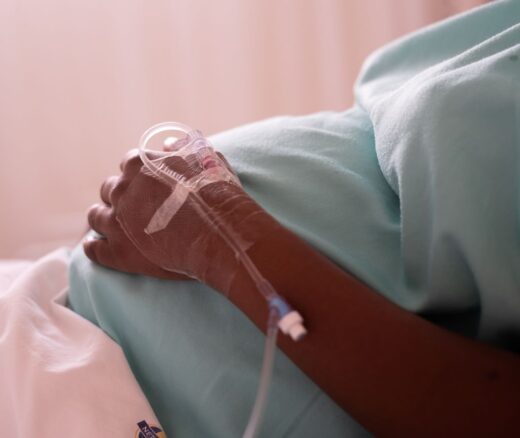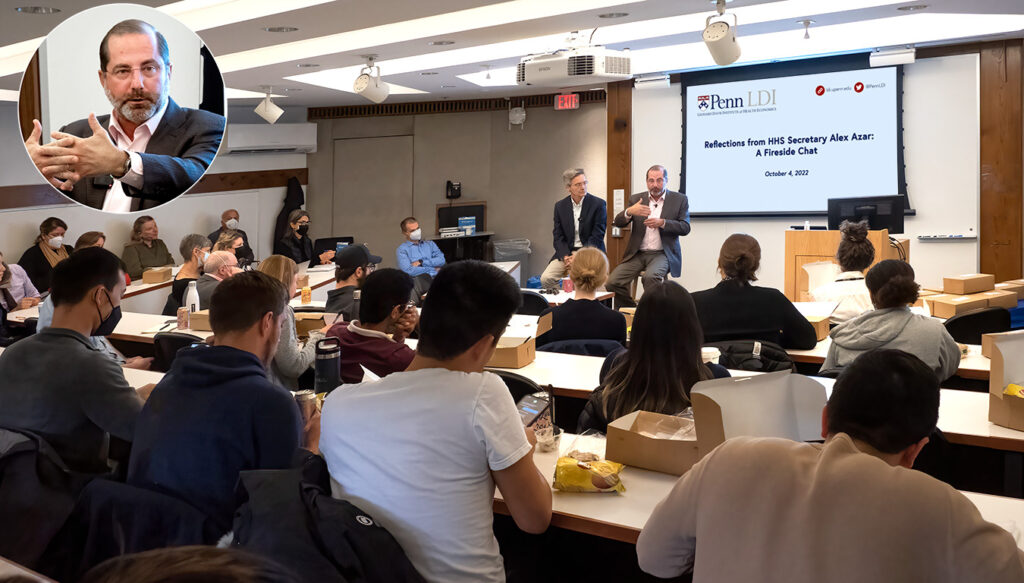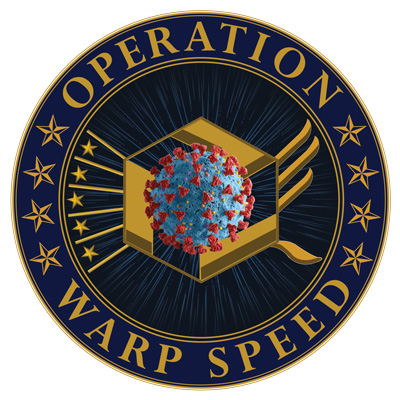
Over 500 U.S. Hospitals Have Stopped Delivering Babies Since 2010
A Crisis in Maternal Care is Unfolding—and it’s Hitting Rural and Urban Communities Alike
News

During his time as head of the U.S. Department of Health and Human Services (HHS) from 2018 to 2021, Alex Azar grappled with all the same daunting challenges his predecessors faced when overseeing the federal government’s largest health care-related agency. But in January 2020 as the first person to alert the White House to the national threat posed by a new strain of deadly coronavirus that had just emerged in China, Azar and his Department faced off against what quickly became, by death toll, the worst U.S. health disaster in modern times.
Currently an Adjunct Professor of Health Management and Policy at the University of Miami’s Herbert Business School, Azar was the guest speaker at the latest in an ongoing series of health policy seminars at the University of Pennsylvania’s Leonard Davis Institute of Health Economics (Penn LDI).
Azar brought with him the deep knowledge of all things health care you would expect from someone with his experience. From 2001 to 2005 he was HHS General Counsel before being promoted to HHS Deputy Secretary (2005-2007) and was engaged in developing and launching the plan for the Bush Administration’s National Strategy for Pandemic Influenza Implementation. Later, from 2012 to 2017, he became President of the U.S. Division of Eli Lilly, one of the world’s largest pharmaceutical companies.

In his seminar remarks, Azar initially talked through his career evolution, the philosophy and logistics of running a government agency with a $1.4 trillion budget and 85,000 employees, and the four areas of interest he was personally focused on during his tenure: drug pricing, restructuring the Affordable Care Act, the opioid crisis and value-based care.
Seminar moderator LDI Senior Fellow and Perelman School of Medicine Professor Kevin Volpp, pointed out that the audience was keenly interested in hearing more about Azar’s role in Operation Warp Speed because so much of the research and development behind the COVID-19 mRNA vaccines was done by Penn faculty researchers who licensed the technologies to Pfizer and Moderna. In response, this was the story that Azar told, (slightly edited for brevity):
“My biggest achievement at HHS and in my life was Operation Warp Speed,” Azar said. “It was really the blending of the Eli Lilly experiences as well as the Bush Administration Pandemic Influenza Implementation Plan experiences together to figure out how, instead of taking 8 to 12 years to get a vaccine, you could do it in seven months.”
“Chinese scientists posted a genetic sequence on January 10th (2020). By January 13th, our scientists at the National Institute of Allergy and Infectious Diseases had already developed a seed strain vaccine from that. And then they partnered that with Moderna, with whom we had already been working with on mRNA technology for about a decade. So, we had an existing contractual relationship there. We partnered with them and eight weeks later were in human trials. It was the fastest time in human history that a (pharmaceutical) product has moved from discovery to actual phase one human trials. So, it was ‘here’s the money, here’s the seed strain.'”
“I had a call at the end of March with Johnson & Johnson (J&J) because we were putting half a billion dollars in, and J&J was putting half a billion dollars in to get a vaccine going there. I asked when will we get vaccine? How much vaccine do we get for this half a billion dollars? ‘No, that’s not part of the deal,’ I was told. What price would we pay? ‘That’s not part of the deal,’ I’m told. I’m big in execution and accountability. So I go back to the team, I ask all these questions, and I create a Secretary’s Scientific Advisory Board that pulls together all the greats at HHS and the fields from the Food and Drug Administration (FDA), Centers for Disease Control and Prevention (CDC), National Institutes of Health, the Biomedical Advanced Research and Development Authority (BARDA), and the HHS Assistant Secretary for Preparedness and Response, and we start looking at our whole portfolio of therapeutics, diagnostics, and vaccines. And it becomes very quickly clear — I knew this from my time in the drug industry — if we just rely on the industry to set its own timelines, it’ll take forever. And why is that? The rap on the drug industry is that it is the riskiest business on Earth that attracts the most risk averse people on Earth. And so, when you’re running a drug company, you’re managing a portfolio and basically trying to manage it horizontally and vertically.”
“The way you do that and manage this risk when you’re placing multibillion dollar bets on individual molecules, is you de-risk. You do that by having multiple products, multiple therapeutic areas, and multiple mechanisms of action. Then, importantly, you de-risk by molecule. Study, learn a bit, wait, invest, study, learn a bit more, then invest. Through this stepwise de-risking or gating of decision making, you learn to de-risk.”
“That’s what slows down the process so much. In addition, manufacturing — especially when you’re dealing with proteins and biologics, as with a vaccine, is where you will manufacture the smallest quantity possible for your clinical trials. To move from, say, a 20-liter bioreactor, which you use for clinical trial materials, to a 2000-liter bioreactor for commercial scale manufacturing is not just a math problem. Proteins are very moody, and they don’t just do what you say. And just because a protein on an E. coli feeder cell line works in a 20-liter bioreactor, doesn’t mean it’s going to work in a 2000-liter one.”
“We had one instance where when you’re pouring out of the bioreactor through a filter to do the filtration, it created a foam that created a hydrostatic barrier back up of the filter and ruined a whole lot. And these are the world’s leading manufacturing people, and they don’t know why that happens. You can’t predict it in advance. So, so much about scaling is difficult. In a drug company, you de-risk. You don’t do that until you know you’ve got a vaccine. You don’t focus on scaling until you have it. So, I brought the team together. I said, Listen, we just spent $2 trillion on COVID-19 pandemic relief in March. So literally any amount of money that we could credibly spend to pull forward vaccines and therapeutics would have an infinite return on investment.'”
“I said we have the money. Don’t worry. If we can make this faster, I can find the money. I’ll go to Congress; we’ll go even to the Office of Management and Budget (OMB) and will make sure we get money. So, take that off the table. And I said just be limited only by the laws of science and physics, so money’s not in your head and let’s get a game plan. And so, Dr. Robert Kadlec, HHS Assistant Secretary for Preparedness and Response (ASPR) and Dr. Peter Marks, Director of the FDA Center for Biologics Evaluation and Research (CBER), along with our team worked up a plan of how we could do this.”
“First, it’s always about people. We had to get a team together and wanted to make sure it had broad support within the government. I didn’t want it to be an Alex project, so I called all my Cabinet colleagues that had anything touching biologic countermeasures — the Agriculture Department, the Energy Department because they’ve got the best computing and data systems on Earth, and Homeland Security because they have countermeasures programs. Then, critically, I called the Department of Defense (DOD) and my colleague and Former Secretary of Defense, Dr. Mark Esper. He was immediately all in and said, ‘this should be you and me — you guys have the brains, and we have the brawn to do this.'”
“And Esper was right. We have a lot of smart people at HHS, but the agency is not known for logistics, operations, procurement, moving freight and things like that. That’s not the core expertise. So, he committed all resources of the DOD, and I committed HHS, and we formed a partnership to do this. We needed to have the right people leading this and eventually were able to secure Moncef Slaoui, the former head of research and development at GlaxoSmithKline (GSK) who, over 10 years, dragged 14 vaccines across the finish line — a historically unprecedented act. We were able to convince him to be head science and development leader.”
“We were able to convince a fellow whose name you haven’t heard of who deserves so much credit — Carlo de Notaristefani — to be head of manufacturing. He had been the head of manufacturing for Bristol-Myers Squibb and then importantly, was at Teva, as global head of manufacturing for that big Israeli generic company. And then Former Secretary Esper contributed. Gustave Perna, a four-star general who was the head of US Army Materiel Command.”
“This is the guy who, when the U.S. Army deploys to Afghanistan, makes sure everything gets there and functions as it should. Just imagine the logistical complexity of that. This is what they do for a living, and we got the best of the best. So, we have these three leaders that pulled all our teams together.”
“We ended up deciding to invest in six molecules, six vaccines across three different platforms. So, we had the old standby traditional measles vaccine kind of platform, which would be protein sub unit vaccines, where you basically get the part of the protein that will cause the body to produce antibodies. And then in the bioreactor, you replicate enough of it, you add an adjuvant to it to provoke the immune response, and then you just inject that in the body. We did two products — Novavax and Sanofi/GSK adjuvant — on that. We had a second platform which was adenovirus. We had just gotten an Ebola vaccine using adenovirus as the vehicle for bringing the RNA into the body and replicating it. It was sort of proven because J&J had an adenovirus Ebola vaccine. So, we did that with J&J and AstraZeneca. And then we had our mRNA platform, which we had with Moderna and then also Pfizer, which basically sends the mRNA through a lipid envelope to protect it as it gets into the cells and causes your cells to basically be its own bioreactor, producing the proteins needed to cause the immune response but that had never been proven before.”
“So, we had to two shots on three different mechanisms. And then we pre-funded everything upfront. We funded all the way through phase III development. So literally as they’re still testing in phase I in 20 people to see if someone will get sick from it, we were standing up clinical trial sites for phase III.”
“In addition, in June, we started in commercial scale manufacturing of vaccines. So, we were making hundreds of millions of doses of vaccine in June of 2020 before some of these products had even entered phase III. Then we did some of the largest clinical trials in human history — 30,000 per vaccine. Why does that matter? Because the way you test therapeutics is sort of easy: Somebody gets sick, you give them (the drug) and see if they get better. In vaccines, it’s different. You take half of your clinical trial subjects, give them the vaccine. The other half you give a placebo sugar shot and you send them out into the wild and see how many people get sick. And then when a certain number of people in the clinical trial get sick, the Data and Safety Monitoring Board (DSMB) allows you to open the black box, look inside, and you see of the people who got sick, how many were vaccinated, how many weren’t. Those are clinical trial results. So, the more people you have in the trial the faster you can get results in addition to a measure of how much the disease burden happens to be in the community. So we pre-funded that.
“Working with the Defense Department through all of this was just so remarkable. If we had an outbreak in Seattle and we didn’t have a clinical trial site there, the DOD could get us stood up within days. We would just move from Nashville to Seattle and start phase III trials there because we could chase the disease burden. It was impressive to see up close the awesome power and might of the US military when deployed in a partnership like this. I really want to give credit there. We could not have done this without Former Secretary Mark Esper, Chairman of the Joint Chiefs of Staff General Mark Milley, and the DOD.”


A Crisis in Maternal Care is Unfolding—and it’s Hitting Rural and Urban Communities Alike

Stable Payments Improved Margins But Not Liquidity, New LDI Analysis Finds

LDI Senior Fellow Cited for “Significant Contributions” in Research

Outdated Laws Target Black and Queer Lives in Over 30 States, Fueling a Deadly Disease

Selected for Current and Future Research in the Science of Amputee Care

Research Memo: Delivered to House Speaker Mike Johnson and Majority Leader John Thune